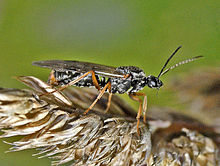Formica rufaspecies group
| Formica rufaspecies group | |
|---|---|

| |
| Formica rufaworker | |

| |
| Formica rufagroup winged male | |
| Scientific classification | |
| Kingdom: | |
| Phylum: | |
| Class: | |
| Order: | |
| Family: | |
| Subfamily: | |
| Genus: | |
| Species group: | F. rufaspecies group
|
TheFormica rufagroupis a subgeneric group within the genusFormica,first proposed byWilliam Morton Wheeler.This group contains the mound-building species ofFormicacommonly termed "wood ants" or "thatch-mound ants", which build prominent nests consisting of a mound of grass, litter, or conifer needles.[1]The speciesFormica rufaor the red wood ant is thetype speciesof this subgroup.

This particular group can inhabit open deciduous woodlands, dense pine forests, and even moorland. Workers vary in size, the largest reaching about 10 millimetres (0.39 in) long. They can produce formic acid in their abdomens and eject it 12 centimetres (4.7 in) in the air when threatened.[2]The only function of males is to mate in flight with queens.[2]Species previously attributed to theMicrogynagroup were transferred to theF. rufagroup by the Wheelers in 1986.[citation needed]
Colonies
[edit]The genetic relationships inF. rufagroup colonies can be complex. Colonies can be polygynous (having multiple queens) and these are often polydomous (having multiple nests per colony). Queens may be singly or multiply mated, and in polygynous colonies, may or may not be related. Colonies are rarely, if ever, independently formed. They either bud off from existing colonies, or are formed by temporarysocial parasitismof colonies ofF. fuscaor other closely related species. A wood ant queen ousts the existing queen, lays eggs, and theF. fuscaworkers raise her offspring until the nest is taken over. Some species in theF. rufagroup sometimes form enormous "supercolonies" consisting of hundreds or thousands of nests. The largest documented example is anF. yessensiscolony in Japan covering 2.7 square kilometres (1.0 sq mi) containing an estimated 306 million workers and 1 million queens.[3]
Member species
[edit]European species include:
- Formica aquiloniaYarrow, 1955
- Formica lugubrisZetterstedt, 1838
- Formica paralugubrisSeifert, 1996
- Formica polyctenaFörster, 1850
- Formica pratensisRetzius, 1783
- Formica rufaLinnaeus, 1761
North American species include:
- Formica ciliataMayr, 1886
- Formica coloradensisCreighton, 1940
- Formica comataWheeler, 1909
- Formica criniventrisWheeler, 1912
- Formica dakotensisEmery, 1893
- Formica fossacepsBuren, 1942
- Formica integraNylander, 1856
- Formica integroidesEmery, 1913
- Formica laevicepsCreighton, 1940
- Formica microgynaWheeler, 1903
- Formica mucescensWheeler, 1913
- Formica obscuripesForel, 1886
- Formica obscuriventrisMayr, 1970
- Formica oreasWheeler, 1903
- Formica planipilisCreighton, 1940
- Formica propinquaCreighton, 1940
- Formica ravidaCreighton, 1940
- Formica reflexaBuren, 1942
- Formica subnitensCreighton, 1940
Asian species
See also
[edit]References
[edit]- ^Gösswald, Karl (1989).Die Waldameise 1.Wiesbaden: Wiesbaden: Aula-Verlag.ISBN3-89104-475-5.
- ^abDr Timothy BatchelorMsu.edu - Southern red wood ant Formica rufa
- ^Bourke, Andrew F. G.; Nigel Rigby Franks (1995).Social Evolution in Ants.Princeton University Press. p. 353.ISBN0691044260.
